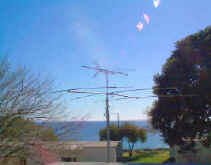Welcome to Handiham World!
It's time for a new HF net.

When was the last time you thought about getting on 20 m and being part of the Handiham net? Don't be embarrassed to admit that you haven't thought about it for a long time. Neither have I, as a matter of fact, so you are not alone. The 20 m net died several years ago when our last regular net control volunteer Mike Knox, WA0KKE, finally had to throw in the towel.
What happened?
Like many things in our technologically-driven existence, there was no single cause for the demise of the Handiham net. A prime suspect certainly had to be the relentless, never-ending sunspot minimum that we are trying to claw our way out of with limited success, even now in 2010 when the sun should be really perking up. As most of you know, the higher solar activity associated with more sunspots creates ionospheric conditions that favor really good high-frequency radio propagation. In a really good solar maximum, the HF bands crackle with strong DX signals and one can "work the world" with just a few watts of power on bands like 10 and 15 m. Sad to say, it has been so long since we have seen those conditions that many operators have simply drifted away from regular HF operation, especially if they did not have room for wire antennas that would allow them to tune 160 through 40 m, bands that remain usable even during solar minimum conditions.
The 20 m band sits astride the critical part of the HF spectrum that just barely remains inside the "always useful" zone. At sunspot minimum, it is generally crowded with DX seekers and anyone else simply looking for an open band with capability of working stations at some distance during daylight hours. Even then, 20 isn't always reliable when solar storms wipe out the bands. So what happened was that the conditions on 20 simply didn't favor continued scheduled net activities. The net control station would be faced with terrible band conditions and fewer and fewer check-ins. In spite of my efforts to find another net control station, no one was interested, and I guess I don't blame them. Who wants to preside over a net with no stations checking in?
But we can't ignore other factors that came into play during the deterioration of the HF bands during the sunspot minimum. The rise of the Internet followed by the spread of broadband connectivity made EchoLink much more practical and reliable than HF communications. The VHF and UHF repeater systems with EchoLink capability came into their own as HF activity deteriorated. More and more people made the move to EchoLink. The Internet is also a huge factor in siphoning away people from ham radio - and most other leisure time activities. It's not that the Internet is good or bad per se, it's just that people only have so much time for all of the competing leisure time activities, and ham radio is simply finding a new "normal" in this very different world.
Another factor is that a daytime 20 m HF net is simply too hard to conduct when more and more people with disabilities are going to school and work, instead of the "bad old days" situation in which people with disabilities simply sat around housebound. We are glad that those days are gone, but Handiham members who work and go to school cannot be expected to have the time to check into a daytime net on any regular basis. You simply can't count on enough folks having a day off from work or a school holiday to keep a critical mass of net participants.
So what to do?
I would suggest a change in net frequency and timing. We need at least consider moving our HF net to 160, 75, or 40 meters, and those bands are likely to be most useful in the evening. Because 160 requires a very long antenna, it is impractical for many users. 40 can get crowded, but requires the shortest antenna of the three. Of course we can consider reviving our 17 meter "non-net roundtable", which was originally started by Alan, K2WS, but the sun will have to spit out a few more spots for that band to get where it needs to be. So what do you think? 160? 75? 40? Or something else? And what about the time and day?
I hope to hear from you about this suggestion soon. Please drop me an email, and I'll share your thoughts with our readers and listeners.
New at the Hong Kong Electronics Fair: Wouxun KG-UV920R

The Hong Kong Electronics Fair opened today, October 13, and runs through October 16.
Amateur radio is about to be introduced to a brand-new entry in the mobile dual-band radio category, the Wouxun KG-UV920R. Although at this time we have little in the way of product specs, the Wouxun dual-band handheld radio that was demonstrated at Handiham Radio Camp early this year created quite a lot of interest because of its built-in speech frequency readout for blind users. The KG-UV920R features dual-frequency display and cross-band repeater capability. It comes with more than a thousand memory channels. It also includes an unusual receiver that covers the short-wave bands! We are waiting for a more detailed specification document so that we can tell if speech frequency readout will be a feature - and we sure hope that it is! At this time, no pricing is available.